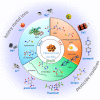Synthesis of Copper Nanocluster and Its Application in Pollutant Analysis
- PMID: 34821639
- PMCID: PMC8615659
- DOI: 10.3390/bios11110424
Synthesis of Copper Nanocluster and Its Application in Pollutant Analysis
Abstract
Copper nanoclusters (Cu NCs) with their inherent optical and chemical advantages have gained increasing attention as a kind of novel material that possesses great potential, primarily in the use of contaminants sensing and bio-imaging. With a focus on environmental safety, this article comprehensively reviews the recent advances of Cu NCs in the application of various contaminants, including pesticide residues, heavy metal ions, sulfide ions and nitroaromatics. The common preparation methods and sensing mechanisms are summarized. The typical high-quality sensing probes based on Cu NCs towards various target contaminants are presented; additionally, the challenges and future perspectives in the development and application of Cu NCs in monitoring and analyzing environmental pollutants are discussed.
Keywords: environmental analysis; explosive; fluorescence; heavy metal; nanocluster; pesticide; pollutant; sensor; sulfide.
Conflict of interest statement
The authors declare no conflict of interest.
Figures








Similar articles
-
Synthesis of Copper Nanoclusters and Their Application for Environmental Pollutant Probes: A Review.Crit Rev Anal Chem. 2024;54(6):1416-1429. doi: 10.1080/10408347.2022.2116555. Epub 2022 Aug 29. Crit Rev Anal Chem. 2024. PMID: 36037057 Review.
-
A sensitive multicolor fluorescence sensing strategy for chlorotetracycline based on bovine serum albumin-stabilized copper nanocluster.Colloids Surf B Biointerfaces. 2023 Aug;228:113404. doi: 10.1016/j.colsurfb.2023.113404. Epub 2023 Jun 15. Colloids Surf B Biointerfaces. 2023. PMID: 37356140
-
Copper nanoclusters as a highly sensitive and selective fluorescence sensor for ferric ions in serum and living cells by imaging.Biosens Bioelectron. 2014 Dec 15;62:189-95. doi: 10.1016/j.bios.2014.06.049. Epub 2014 Jun 27. Biosens Bioelectron. 2014. PMID: 24999996
-
Encapsulating gold nanoclusters into metal-organic frameworks to boost luminescence for sensitive detection of copper ions and organophosphorus pesticides.J Hazard Mater. 2023 Jan 5;441:129890. doi: 10.1016/j.jhazmat.2022.129890. Epub 2022 Sep 5. J Hazard Mater. 2023. PMID: 36084467
-
Fluorescent noble metal nanoclusters for contaminants analysis in food matrix.Crit Rev Food Sci Nutr. 2023;63(19):3519-3537. doi: 10.1080/10408398.2021.1990010. Epub 2021 Oct 16. Crit Rev Food Sci Nutr. 2023. PMID: 34658279 Review.
Cited by
-
Highly Selective Detection of Paraoxon in Food Based on the Platform of Cu Nanocluster/MnO2 Nanosheets.Nanomaterials (Basel). 2022 Apr 22;12(9):1429. doi: 10.3390/nano12091429. Nanomaterials (Basel). 2022. PMID: 35564138 Free PMC article.
-
Recent Advances of Strategies and Applications in Aptamer-Combined Metal Nanocluster Biosensing Systems.Biosensors (Basel). 2024 Dec 18;14(12):625. doi: 10.3390/bios14120625. Biosensors (Basel). 2024. PMID: 39727889 Free PMC article. Review.
-
Multifunctional copper-glutathione clusters with superior p-nitrophenol degradation and horseradish peroxidase-like activity.RSC Adv. 2025 Mar 24;15(12):8889-8900. doi: 10.1039/d5ra00897b. eCollection 2025 Mar 21. RSC Adv. 2025. PMID: 40129636 Free PMC article.
-
Analytical developments in the synergism of copper particles and cysteine: a review.Nanoscale Adv. 2024 May 17;6(14):3476-3493. doi: 10.1039/d4na00321g. eCollection 2024 Jul 9. Nanoscale Adv. 2024. PMID: 38989510 Free PMC article. Review.
-
Rational Fabrication of Copper Nanoclusters and In Vitro Study of Antioxidant Property.Nanomaterials (Basel). 2025 Feb 26;15(5):360. doi: 10.3390/nano15050360. Nanomaterials (Basel). 2025. PMID: 40072164 Free PMC article.
References
-
- Liu X., Astruc D. Atomically precise copper nanoclusters and their applications. Coord. Chem. Rev. 2018;359:112–126. doi: 10.1016/j.ccr.2018.01.001. - DOI
Publication types
MeSH terms
Substances
Grants and funding
LinkOut - more resources
Full Text Sources

